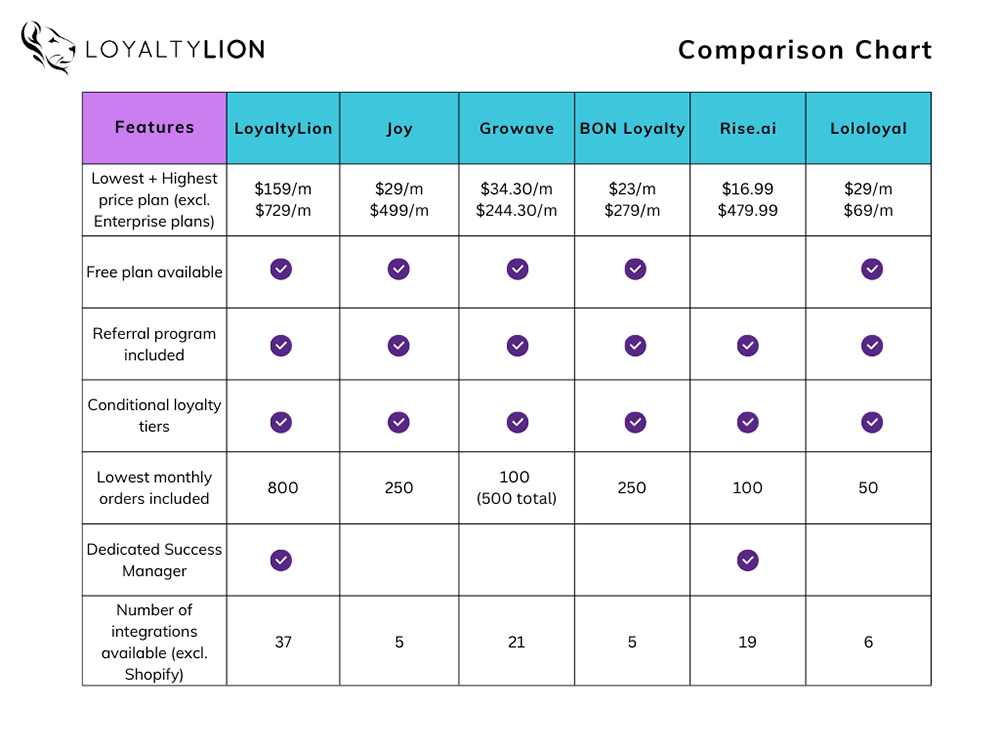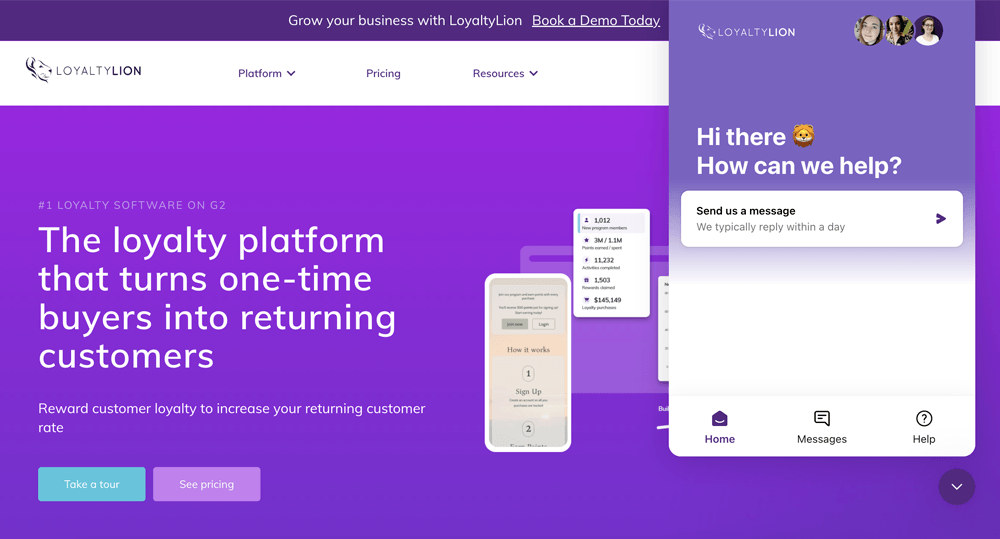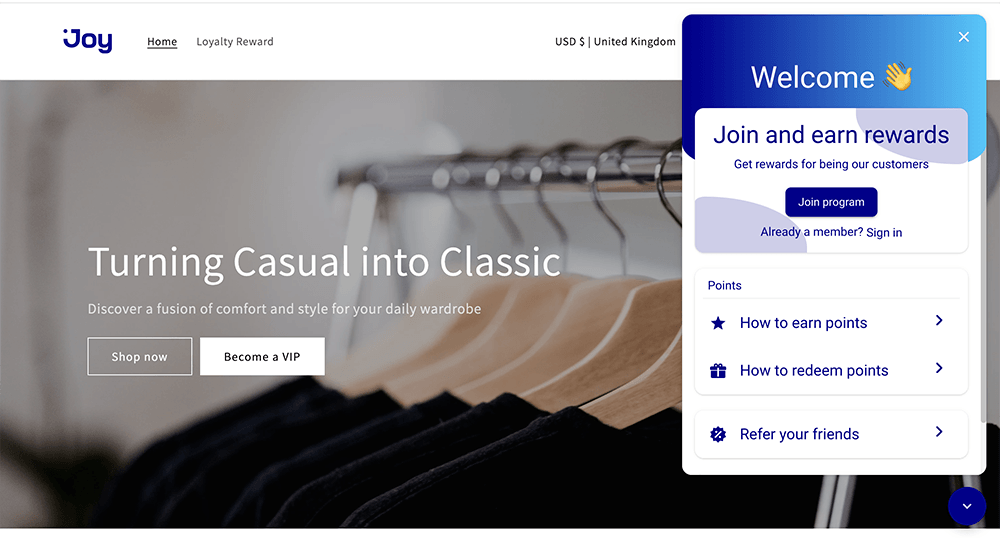In a world where ecommerce behemoth Amazon accounts for almost half (45%) of the ecommerce market share in the US, how can independent Shopify store owners compete?
The answer lies in customer loyalty programs — over a quarter (27%) of D2C shoppers cite loyalty programs as a leading motivation for shopping directly with a brand. On top of that, almost half (48%) of customers show their loyalty to a brand by joining its loyalty program.
Loyalty programs can offer Shopify store owners significantly improved customer retention, which in turn leads to greater revenues. So, as a Shopify store owner, how can you build a loyalty program for your store? One easy method is by using one of the Shopify loyalty apps, available within its app store.
However, you might run into another issue when you go to the app marketplace — there are (at the time of writing) 212 listings for loyalty program apps. Having such a massive variety can make it difficult to see which one is right for your business.
In this guide, we’ll be covering the following key areas to help you narrow down your choices:
- Understanding your needs and defining your loyalty program goals
- A Shopify loyalty app showdown and deep dives into popular choices
- Unveiling hidden factors you should consider when choosing a loyalty program app
- Optimizing your program for success.
By the end of this guide, you should have a clearer view of your loyalty needs as a business owner and some key competitors in the space and be able to choose the best loyalty app for Shopify based on your needs.
Understanding your needs: defining your loyalty program goals
In this section of the guide, we’ll cover some of the factors you’ll want to have a good understanding of before you start looking at Shopify loyalty program app options, starting with identifying your key objectives.
Identifying key objectives
Having key objectives is a critical component of building out your loyalty program — they give you the means for measuring the program’s effectiveness and its relationship to your overall business goals.
We have published a great resource on this topic already:
Read more:
Loyalty program objectives: 7 examples of goals for ecommerce brands
That being said, here are some common objectives (or KPIs) you’ll want to consider for your loyalty program:
- Retain customers and reduce churn rates
- Increase average order value
- Increase purchase frequency
- Improve customer lifetime value (CLV)
- Acquire new customers cost-effectively
- Even out seasonal fluctuations in revenue
- Reward existing customers and increase customer satisfaction
These are great objectives to start with. However, as your program starts to gather longer-term data, you can create benchmarks against these objectives to track and optimize your program for growth.
Matching needs with features
With your objectives in mind, you can start thinking about what loyalty program features will help you achieve them. Let’s take a look at a few examples.
If you choose to focus on encouraging repeat purchases among your customers, a points-based system can help you. When customers earn points from purchases that they can then use to claim free shipping or a dollar amount off their next order, they’re likely to purchase again.
One example of a brand that does this well is Lucy & Yak. Their program gives customers a £10 voucher for every 1000 points they earn, and this tactic resulted in an 80% increase in spending and a 78% increase in order frequency.
If you wanted to focus on cost-effective customer acquisition, having a referral program embedded within your loyalty program would be the way to go.
OFRA Cosmetics used a two-sided referral program, which rewarded the referred friend $10 off their first purchase and 1,500 points for the customer who referred them if their friend spent over $20. This strategy resulted in over $183K in additional revenue attributed to the referral program.
Finally, to help with customer retention and satisfaction, you can implement a tiered loyalty program that offers greater and more experience-based rewards the more a customer spends with you (or the more points they earn).
A brand that does this with significant success is Astrid & Miyu. Revamping their tiered loyalty program they drove a 40% increase in total revenue, and program members now purchase 220% more per year than non-members.
The Shopify loyalty app showdown
In this section, we’ll cover some of the top-rated loyalty programs to help you streamline your research. Here’s a quick comparison table for a top-level look at some providers:

In the above chart, you can see how each program compares in terms of offered features and limitations.
Shopify loyalty app deep dives
Let’s take a deeper dive into the top three contenders in that chart: LoyaltyLion, Joy, and Growave.
LoyaltyLion

Key features:
- Unlimited loyalty members, even on the free plan
- Dedicated integrated and customizable loyalty page
- 800 orders included on the free plan
- Customizable loyalty tiers
- Dedicated Onboarding Manager and regular program reviews on paid plans
- Customer Value Snapshot Analytics
- On-site notifications
- Add extra features from only $5/m
- 37 integrations for email, SMS, helpdesk, reviews, subscriptions, ESP, and more
Full features and pricing are available on loyaltylion.com
Pricing: Free plan available, Small Business $159/m, Classic $399/m, Advanced $729/m
LoyaltyLion is a great option for both new and established Shopify stores, with lots of features, 37 integrations available, and a generous 800 monthly order limit on the free plan to help store owners get started without a low order cap.
Joy

Key features:
- Conditional loyalty points-based tiers
- Unlimited orders on paid plans
- 5 integrations, including Klaviyo and Loox
- Custom email content
- Import transactions
- Dedicated loyalty page
- Multiple loyalty programs on sets of products
- API and Webhooks
Full features are available on lifesight.io
Pricing: Free plan available, Pro $29/m, Advanced $99/m, Enterprise (Plus) $499/m
With a $29/m Pro plan, Joy is a good value option for new stores looking to get started with ecommerce loyalty programs. However, its small number of integrations could pose an issue for store owners with an existing tech stack. It could also be challenging to scale your program.
Growave

Key features:
- Choice of 21 integrations (but can’t use any on the free plan; medium plan comes with one integration, unlimited integrations only on the Premium tier)
- 24/7 customer support
- Customizable emails
- Custom domain for referrals
- Custom domain for sending emails
- Integrated reviews system
- Wishlist reminders
- Instagram UGC
Full features and pricing are available on growave.io
Pricing: Free plan available, Medium from $34.30/m, Growth from $104.30/m, Premium from $244.30/m, Enterprise available on request. Note there was a sale at the time of writing — these prices may have increased since publishing this guide.
Growave is a good middle-tier option for stores looking to grow on a lower budget with interesting embedded features like Wishlist reminders and Instagram UGC (best use-case would be for apparel stores). However, the free plan is minimal — only 500 total orders are included, and integrations are limited until the Premium tier.
Beyond features: Unveiling the hidden factors
Having many features that line up with your business objectives is an obvious win, but there are a couple of hidden factors you’ll also want to consider when narrowing down your loyalty app contenders.
Integration with your tech stack
Loyalty programs work best when they seamlessly integrate and are compatible with your existing tech stack, not running on their own in a silo.
One critical integration to think about is your email service provider. Without compatibility with your ESP, you won’t be able to send automated loyalty-related emails, e.g., incentivizing your customers to use their earned loyalty points.
If your store offers a subscription service, you’ll want to make sure it’s integrated with your loyalty program to help reward your subscribing customers to reduce churn.
These types of integrations can help you not only improve the effectiveness of each tool but also help keep your customer data management neatly in order.
Scalability and future growth
Some apps limit the number of orders and members their programs accommodate, which is an obvious issue when you’re looking to scale and grow your business.
To help combat this issue, you’ll want to choose a program that can be flexible to your business needs — whether that’s seamless account upgrades or the ability to pay for additional orders or members on an ad hoc basis.
Customer support and community
You never want to experience a heart-stopping moment like your program going down suddenly — but it can happen. When problems come up, you’ll want to make sure you can get high-quality support from your program provider to get you back up and running ASAP.
Another aspect to consider is how your loyalty program provider can act as a business partner — with a Customer Success team providing regular support and offering advice for improvement.
Lastly, you’ll also want to consider if the provider offers community resources and forums where you can learn how to improve your loyalty strategy whenever you want to — LoyaltyLion has the LoyaltyLion Academy as an example.
Making the final choice: Tips for selecting the perfect loyalty app
When narrowing down your loyalty app choices, remember to go back to your business goals and objectives.
Make a list of features to help you achieve those objectives and use them as your “deal-breaker” if the loyalty app doesn’t have the features you need.
Another factor to consider if you’re still struggling to figure out how to choose a platform and build a base of loyal customers is to look for expert advice and services — LoyaltyLion offers a list of vetted agency partners that can help you hit the ground running.
Optimizing your loyalty program for success
Choosing among the best loyalty programs for Shopify should take some meaningful thought, even if you choose to go through an agency. But choosing the right app isn’t the end of your loyalty journey — it’s only the beginning.
Once you’ve picked your program, you’ll want to optimize it for maximum success and impact — here are a few tips to get started:
- Use activity rules to improve customer engagement: reward customers for easy activities like social media following, newsletter signups, and giving their information for birthday rewards to help them get the ball rolling.
- Customize your referral program email and messages: you know your customers best — instead of using the default template messages, change them to suit your customer’s language and preferences.
- Turn your guest shoppers into program members: reward account creation and set up a “reward historic purchase” rule; then, when you engage with your guest customers by email, highlight these benefits, and it’ll be almost irresistible to stay away.
Are you ready to take the first step on your customer loyalty journey and create a loyalty program for your Shopify store?
Check out the LoyaltyLion pricing and features page to see how the LoyaltyLion solution can help to grow your Shopify store to new heights.





